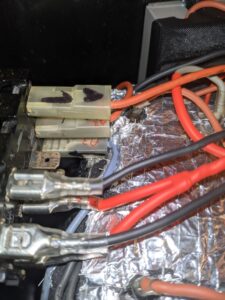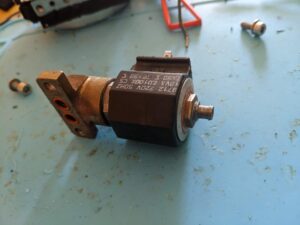
I think that in order to better understand the modding process of an espresso machine, you need to first understand how it’s working.
What I bought for my project was a roughly 20 years old Gaggia Classic, in a quite rare black Coffee version. Still, in regard to how it’s built, it’s the same as Gaggia Classic v1. What was really interesting to me, is that this machine uses no electronics at all: everything is driven directly using the AC power and switches on the front of the machine – really nice and simple solution!
How coffee is made
When a machine is turned on, it turns on both heaters integrated with the water boiler. Depending on whether the machine is in ‘coffee brewing’ mode or ‘steaming’ mode, there’s one of two thermocouples included in the circuit with the heaters (one disconnects when the boiler gets to ‘coffee brewing’ temperature, the other disconnects when it gets to a higher ‘steaming’ temperature). By default, they are internally connected (on), but when they reach a certain temperature, they break (turn off internally) the circuit and boiler heaters stop working. When the water in the boiler cools down a bit, the thermocouple switches back on and heaters start again. That way, the machine executes its first function: heating water. By the way, this process is what is causing some problems in espresso brewing: the difference between off-and-back-on temperatures (called hysteresis) of the heating circuit can be as high as 10 °C, which will already impact the taste of espresso. The PID controller we want to add will keep our temperature within 1-2 °C of the target value.
Unless you flip the brewing switch, nothing else happens. When you do, the brewing process looks like this:
- The pump starts pumping the water from the water tank to the hose that goes to the Over-Pressure Valve (OPV). The pressure of this water is roughly 15 bar.
- Next, the water goes through OPV. In general, you can have OPV in a form of a simple plastic wedge, that is pushed against the water current by a spring or a full regulated OPV. My advice: don’t even buy machines that have the simple one. Gaggia Classic v1 has a regulated OPV valve. This valve has 1 input and 2 outputs, so to speak. The water flows in and pushes internally on a spring-loaded rubber seal. If the pressure is low, the seal holds and all the water goes out through the first output, which is used to brew coffee. When the pressure of the water is high enough, the spring is compressed, the seal opens and some water gets out the 2nd overflow output of the valve. This output leads back to the water container, where there’s no resistance on the way, so there’s also no pressure buildup and any excess water can flow this way. That allows the OPV to limit the water pressure to a constant value – the one that is needed to open the overflow output. By regulating a nut within the OPV you can preload the spring as hard as needed and that way also regulate the pressure at which the overflow opens. Still, to calibrate the OPV precisely, you need to connect a pressure gauge somewhere. One option to do that is to block water output out of the coffee group using a blind sieve, then split the water hose and connect your gauge there. The other, simpler way, is to connect the pressure gauge to your normal portafilter, blocking water outflow using the gauge directly. So, here’s the 2nd step of the espresso process: setting the water pressure to a correct value, typically 9 bar.

Over Pressure Valve (OPV) - After the OPV, the water passes through a 3-way valve. In theory, this part is not really needed, but you still want to have it. The way this valve works is that it has 3 connections: from the OPV (so the water you want to brew your coffee with), one exits to the coffee group (where you want your water to go to make a coffee) and the second output to the drip tray. The 3-way valve works by enabling one or (actually xor 😉 the other of paths water can flow. When the AC power is enabled, the valve allows water to flow between OPV and the coffee group, but blocks output to the drip tray. When it’s not energized by AC, it allows the water to flow between the coffee group and the drip tray. Why is it useful? Just after finishing the brew, there’s still quite high pressure in the coffee group and your portafilter. If you remove your portafilter from the group while there’s still some pressure, droplets and bits of coffee will start flying around your kitchen! To avoid that, as soon as you turn off the water pump, also the 3-way valve is turned off and allows the extra pressure to be released to the drip tray through the 2nd path.

3 Way Valve - Now we’re almost done. We have water at the right temperature and pressure, we’re protected from a mess by the 3-way valve, we can just push out the hot water from the boiler into the portafilter – it is the fresh water coming from the water tank that is pushing out the hot water from the boiler onto your coffee. So, put your ground coffee into the portafilter and let the water flow!
